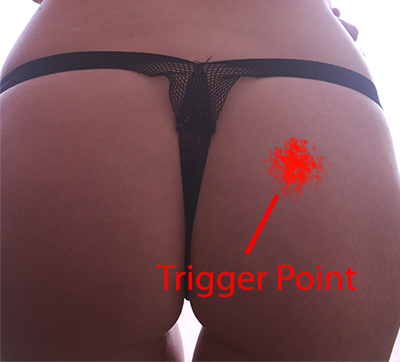This example includes treatment for both myofascial release and trigger point therapy using radial shockwave.
The myofascial release is to the glutes and the trigger point therapy is to the piriformis. These areas are often found to be dysfunctional together.

Shockwave trigger point therapy uses the concept of mechanical energy separating the fixed actin-myosin links (Travel & Simons, 1983), breaking of contraction ‘knots’ (Mense & Simons, 2001), improvement in local blood circulation through reactive hyperaemia and resolution of the ischaemia-induced energy crisis (Sikdar et al, 2010), reduced concentration of vasoneuroactive substances (Shah et al, 2008) as well as muscle relaxation.

Fascia is a thin, tough, elastic type of connective tissue that wraps most structures within the human body, including muscle. Fascia supports and protects these structures. Osteopaths believe this soft tissue can become restricted due to psychogenic disease, overuse, trauma, infectious agents, or inactivity. This can result in pain, muscle tension, and corresponding diminished blood flow. Although fascia and its corresponding muscle are the main targets of myofascial release, other tissue may be addressed as well, including other connective tissue (DiGiovanna, Schiowitz, and Dowling, 2005). Shockwave works as a direct myofascial release method and is used to engage the myofascial tissue “restrictive barrier” (tension). Direct release is achieved with shockwave as it can mechanically influence muscles. The physiological intrinsic oscillations of 15 to 30 Hz have been described by Nazarov & Gorozhani (1988) as important for muscular relaxation, blood circulation and lymphatic drainage. Travell & Simons (1983) and Shah et al. (2008) said these oscillations could led to breaking of Actin-Myosin-Links, whilst Mense & Simons (2001b) said shockwave could lead to the destruction of damaged fibres. All of which should reduce myofascial tension.

Extracorporeal shockwave to the piriformis and glutes
Machine: Gymna Shockmaster 300
Settings Trigger point: 3.0bar 200 shocks per spot for 3 spots at 10hz
Settings Myofascial Release: 1.6bar 2000 shocks at 16hz
Medium: Ultrasound Gel
Patient: Demonstration video of technique only
Theory:
Muscle treatment with shock waves (focused) was first seen in the 1990s (Kraus et al, 1999, Lohse-Busch et al, 1997). It was used as an alternative to manual trigger point treatment. The results of these treatments was reduction in pain, lower muscle tone and decreased muscle shortening. Shockwave moved into the treatment of myofascial syndromes started in the 2000s. Initially, radial shock waves (r-ESWT) were used for myofascial problems (Bauermeister, 2003, Gleitz, 2003), but focused shock waves followed (Bauermeister, 2005, Bauermeister, 2007, Gleitz et al, 2006, Muller-Ehrenberg, 2005). Shockwave has been shown to be effective in muscular treatments through various mechanisms. Studies have shown separation of fixed actin-myosin links by the input of mechanical energy (spalling) as long as the force is perpendicular to the muscle fibre direction (Shah et al, 2008, Travell & Simons, 1983). Circulatory effects e.g. improvement of blood circulation through reactive hyperaemia and angioneogenesis (Shah et al, 2008, Kuo et al, 2009, Wang, 2003) and dilution of vasoneuroactive substances as a result of reactive hyperaemia (Shah et al, 2008, Mense & Simons, 2001). Improvements in pain through pain modulation by the release of substance P (Hausdorf et al, 2008, Maier et al, 2003) and CGRP (Takahashi et al, 2003), release and synthesis of nitric oxide (Mariotto et al, 2009, Neuland, Duchstein & Mei, 2004), selective degeneration of C-fibres (Hausdorf et al, 2008), decreases due to the pain gate control theory (Gregor & Zimmerman, 1972, Wall & Cronly-Dillon, 1960) and reduction in muscle tone through biological mechanotransduction (Ingber, 2006, Jaalouk & Lammerding, 2009, Neuland, Duchstein & Mei, 2004).
Trigger point treatment can be separated into two areas: to alleviate pain and to permanently eliminate the trigger point complex. Shockwave trigger point therapy uses the concept of mechanical energy separating the fixed actin-myosin links (Travel & Simons, 1983), breaking of contraction ‘knots’ (Mense & Simons, 2001), improvement in local blood circulation through reactive hyperaemia and resolution of the ischaemia-induced energy crisis (Sikdar et al, 2010), reduced concentration of vasoneuroactive substances (Shah et al, 2008) as well as muscle relaxation.